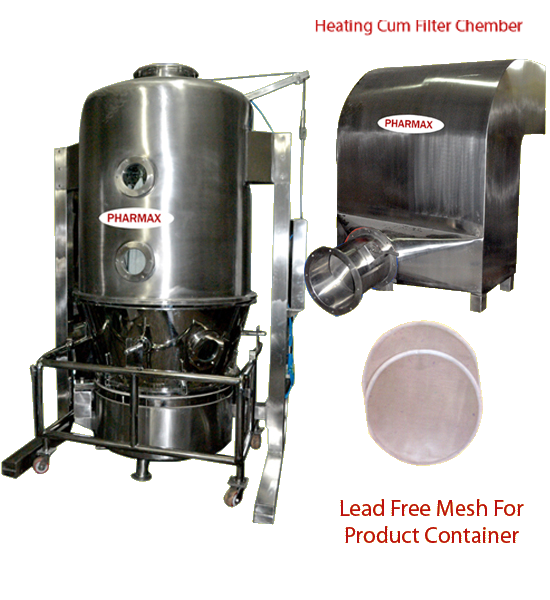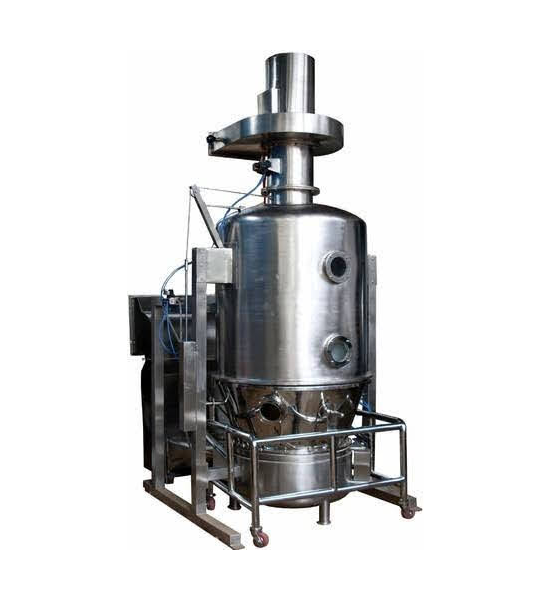Fluid Bed Dryer (FBD) equipment for pharmaceutical industry in Mumbai
A Fluid Bed Dryer (FBD) is a highly efficient piece of equipment used for drying granulated materials, powders, and agglomerates. Utilizing fluidization, this dryer offers uniform drying and improved product quality, making it indispensable in various industries.
A Fluid Bed Dryer is designed for fast and uniform drying of powders, crystals and medium sized pellets. The Fluid Bed Dryer finds applications in Pharmaceutical Bulk Drugs, Dyes & Chemicals, Phyto-Chemicals, Catalysts Food Products & Pesticides etc.
Fresh air is drawn in by means of a blower. The suction of fresh air takes place from the AHU The air is then
heated to produce hot air by use of electric heaters/steam Radiator/Thermic fluid. If the product contains a solvent or inflammable substances, the dryer must be operated using steam and provided with a flame-proof motor.
The heated air passes through the product container which has diffuser plates and a sieve. Due to the stream of air, the wet product gets fluidised. The material gets surrounded by the hot air and gets dried due to heat transfer. Moist air passes through a filter bag and an exhaust duct.
The Fluid Bed Dryer is not suitable for drying of liquids or paste. A Fluid Bed Dryer (FBD) is a highly efficient piece of equipment used for drying granulated materials, powders, and agglomerates. Utilizing fluidization, this dryer offers uniform drying and improved product quality, making it indispensable in various industries.
Specifications
• 1. Material of Construction: Fluid Bed Dryers are typically made from stainless steel (304 or 316) to ensure durability, resistance to corrosion, and compliance with hygiene standards.
• 2. Capacity: Available in a range of capacities, from small laboratory models handling a few kilograms to industrial-scale units capable of drying several tons per batch.
• 3. Temperature Range: Can operate at a wide range of temperatures, typically from 30°C to 200°C, allowing for versatility in drying different materials.
• 4. Air Flow: Equipped with adjustable air flow systems to control the fluidization and drying rate, ensuring optimal drying conditions.
• 5. Heating Options: Various heating methods are available, including electric, steam, and gas-fired heaters, to suit different energy preferences and requirements.
• 6. Control Systems: Advanced models feature programmable logic controllers (PLC) and human-machine interfaces (HMI) for precise control over temperature, airflow, and drying time.
• 7. Filter System: Includes high-efficiency particulate air (HEPA) filters to ensure clean air during the drying process and prevent contamination.
• 8. Discharge: Easy discharge mechanisms, such as automated discharge valves or tilting options, to facilitate quick and efficient unloading of dried material.
Advantages
• 1. Uniform Drying: Provides even drying of particles due to the fluidization process, resulting in consistent product quality.
• 2. Efficiency: High drying rates and shorter drying times compared to conventional drying methods, enhancing productivity.
• 3. Versatility: Suitable for drying a wide range of materials, including pharmaceuticals, chemicals, food products, and more.
• 4. Energy Savings: Efficient heat transfer reduces energy consumption, making the process cost-effective.
• 5. Scalability: Available in various sizes and capacities, allowing for easy scalability from laboratory to production scale.
• 6. Gentle Handling: Gentle fluidization process minimizes particle attrition and degradation, preserving the quality of sensitive materials.
• 7. Hygienic Design: Meets stringent hygiene standards, with easy-to-clean surfaces and components to prevent contamination.
• 8. Automation: Advanced control systems enable precise process control, reducing the need for manual intervention and ensuring repeatability.
| Model | PE-5 | PE-30 | PE-60 | PE-120 | PE-150 | PE-200 | PE-250 | PE-300 | PE-500 |
| Container Vol. (Lts) | 12 | 90 | 210 | 430 | 530 | 650 | 820 | 900 | 1750 |
| Batch Capacity in Kg | 3-5 | 30-40 | 60-75 | 120-130 | 150-160 | 200-225 | 250-280 | 300-325 | 500-550 |
| Drying Temperature in ° C | 50-80 | 50-80 | 50-80 | 50-80 | 50-80 | 50-80 | 50-80 | 50-80 | 50-80 |
| Motor H.P. | 2 | 7.5 | 10 | 20 | 20 | 25 | 30 | 30 | 60 |
| Electrical Heating Load (If Required) | 6 | 18 | 36 | 54 | Electrical Heating Not recommended | ||||
| Approx Steam Consumption | - | 143 | 195 | 260 | 300 | 335 | 425 | 550 | 760 |
| DOCUMENTATION | Documentation like DQ, IQ, OQ And FAT provided with the machine | ||||||||
Applications
• 1. Pharmaceutical Industry: Widely used for drying granulated materials, active pharmaceutical ingredients (APIs), and excipients. Ensures consistent moisture content, critical for tablet production and other pharmaceutical formulations.
• 2. Food and Beverage Industry: Applied in the drying of food products such as milk powder, coffee, tea, and spices. Ensures uniform drying and preservation of flavor, color, and nutritional value.
• 3. Chemical Industry: Used for drying chemicals, catalysts, and polymers. Provides efficient and uniform drying, which is essential for subsequent processing steps.
• 4. Agriculture: Utilized for drying seeds, grains, and fertilizers, enhancing storage stability and ease of handling. • 5. Biotechnology: Essential in drying biological products such as enzymes, proteins, and other bioproducts. Ensures product stability and activity.
• 6. Cosmetics: Used for drying raw materials and intermediate products in the production of cosmetics and personal care items. • 7. Minerals and Metals: Applied in the drying of minerals, metal powders, and ores, ensuring uniform moisture content for further processing.
• 8. Research and Development: Integral in R&D settings for drying experimental batches, allowing for precise control over drying parameters.


